How do you increase home value? That’s a popular question for every homeowner. Whether you’ve just bought a home or owned a home for years, learning how to increase home value is important. First, look around your property. Do you see any areas with dirt, overgrown weeds, or unwanted plants growing? Those are prime areas to plant flowering ground cover plants.
Flowering ground cover plants are a simple way to beautify your property, improve curb appeal, and enhance the attractiveness of the front of a home. Check out our recommendations for the best flowering ground cover plants.
Landscaping Adds Home Value
One proven upgrade for new homeowners and long-time homeowners is landscaping. The American Society of Landscape Architects (ASLA) has recommended that homeowners invest up to 10% of their home’s value into landscaping.[1] Studies from real estate companies have found that landscaping upgrades can add between 5-15% to the overall property value.[2] And homes with a high curb appeal sell for up to 7% more on average according to a study from and the University of Texas at Arlington and the University of Alabama.[3]
Landscaping upgrades add curb appeal, a common phrase in real estate that describes how attractive the home looks when viewed from the curb. Proper lawn care and maintenance are also important for curb appeal. Hardscaping features such as pavers and stone walls contribute to a beautiful front but come at a high cost.
One key landscaping feature that benefits practically any home is the addition of flowering plants and ground covers. Most properties have sections and corners that can visibly improve from just the addition of flowering ground covers and flowering ground covers complement just about any other addition including custom gardens, rock walls, and trees.
Why Choose Flowering Ground Covers
Considered highly desirable for landscapers and homeowners alike, flowering ground cover plants provide many of the benefits of ground covers with the added benefit of vibrant blooms. Flowering ground covers also help inspire relaxation and enjoyment in the backyard or on the side of the house the way a mixed flower arrangement beautifies the inside of your home.
For aspiring gardeners or just homeowners looking to spruce up their homes this summer, here are our picks for the best ground covers that can increase the value of your home. Consider planting a complementary mix across areas of your property to increase interest. Plant heights can be important depending on where you want to plant and how you want to plan your landscaping.
Best Flowering Ground Covers
Native varieties in your region will be the easiest to maintain and the most vigorous.
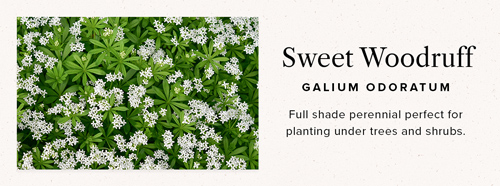
Sweet Woodruff (Galium odoratum)
| USDA Hardiness Zone: | 4-8 |
|---|---|
| Soil: | Moist but well-draining |
| Sun: | Full Shade |
| Blooms: | May and June |
These star-shaped white blossoms usually grow 8-12 inches above the ground. As a full shade perennial, they are perfect for planting underneath shrubs, tall trees, and around the corners of your house. Suitable for creating a woodland effect or just filling in space under that mature tree in your front yard.
Cotoneaster (Cotoneaster horizontalis)
| USDA Hardiness Zone: | 5-7 |
|---|---|
| Soil: | Moist, loamy soil |
| Sun: | Full sun to partial shade |
| Blooms: | Spring for flowers, summer for fruit |
Cotoneaster is actually a shrub but its horizontal growth makes it suitable for a variety of ground cover situations. It blossoms in pink and white but it’s known for its small, red berries. This combination of pink and white flowers with small red berries makes it attractive to use as a ground cover that can add some bold colors to your garden.
Lily of the Valley (Convallaria majalis)
| USDA Hardiness Zone: | 3-8 |
|---|---|
| Soil: | Wide range of soils from sandy to clay |
| Sun: | Full shade |
| Blooms: | Spring and summer |
Its fragrant, bell-shaped white blossoms make Lily of the Valley an attraction option. It grows up
to 8-12 inches and spreads well. However, be careful on property borders. It can creep over your property lines so keep that under consideration. It does best in cool weather. We don’t recommend planting Lily of the Valley in areas with hot and humid summers.

Thyme(Thymus serpyllum, Thymus praecox, and more)
| USDA Hardiness Zone: | 5-9 |
|---|---|
| Soil: | Average to moist soil that drains well |
| Sun: | Full sun and loves the heat |
| Blooms: | May to September |
Thyme comes in many varieties that make all excellent ground covers. It has many traits making it highly desirable for ground cover. It grows horizontally, only attaining about 3 inches. It distributes a pleasant minty scent. It has a long bloom season through spring and summer. And, it can be harvested for a popular herb. It blooms with attractive pink, purple, red, and white blossoms depending on the variety. Frequent pruning can keep it thriving and reduce the woody effect.
‘Six Hills Giant’ Catmint (Nepeta x faassenii)
| USDA Hardiness Zone: | 4-8 |
|---|---|
| Soil: | Well-draining soil |
| Sun: | Full sun or partial shade |
| Blooms: | Early summer to early fall |
Violet-blue blooms that repeatedly bloom through the growing season make this variety of nepeta a particular favorite for ground cover applications. The Six Hills Giant variety is not drought tolerant as its cousins so it prefers moist soil. It’s a low-maintenance plant that can be incorporated into a wide variety of scenarios where ground cover is needed. It can be used on property borders, in gravel and wildlife gardens, and trailing over walls. It also looks great as an underplanting for roses since it can hide the bottom of the rose bush and complement most rose colors.
Lamb’s Ear (Stachys byzantina)
| USDA Hardiness Zone: | 4-8 |
|---|---|
| Soil: | Well-draining soil |
| Sun: | Full sun or partial shade |
| Blooms: | Early summer |
Lamb’s ear can tolerate even the worst soil composition as long as it’s well-draining and doesn’t remain too moist. It grows low and the foliage forms a nice mat-like carpet which gives it plenty of uses for a variety of gardens. It can be grown as a border cover surrounding other perennials or it can be used within barriers and planters.
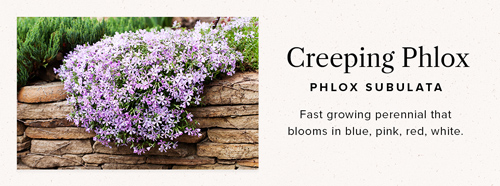
Creeping Phlox (Phlox subulata)
| USDA Hardiness Zone: | 3-9 |
|---|---|
| Soil: | Rich soil |
| Sun: | Partial shade to full sun |
| Blooms: | March to May |
A fast-growing perennial, Phlox is a great choice for an area you want to keep filled with greenery. The creeping variety that usually stays between 2 and 6 inches is most popular but you can try another variety, just ask your local nursery. It blossoms in shades of pink, red, white, blue, rose, lavender and purple.
Roman Chamomile (Chamaemelum nobile)
| USDA Hardiness Zone: | 4-9 |
|---|---|
| Soil: | Light soil, no heavy, clay soils |
| Sun: | Full sun or partial shade |
| Blooms: | Early summer to fall |
Grows low and spreads well with beautiful, aromatic flowers. Its blooms can be used to make herbal teas that have been used for a variety of remedies.
Rock Cress (Aubrieta deltoidea)
| USDA Hardiness Zone: | 5-7 |
|---|---|
| Soil: | Well-draining soil |
| Sun: | Full sun |
| Blooms: | April and May |
Rock cress blooms with rich violet-blue flowers to dark purple flowers that emit a sweet scent
Rock cress naturally spreads horizontally, hugging the ground usually between 4 and 9 inches. It’s perfect to plant along pathways, in the crevices of rock walls, between stepping stones, and on banks and slopes. It may attract butterflies, bees, and hummingbirds. It’s also resistant to deer so it makes an outstanding choice to surround many types of gardens.
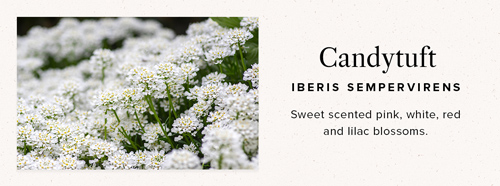
Candytuft (Iberis sempervirens)
| USDA Hardiness Zone: | 3-8 |
|---|---|
| Soil: | Well-draining soil |
| Sun: | Full sun, drought-tolerant |
| Blooms: | April to May |
With its sweet-scented white, pink, red, or lilac blossoms, and growing habits, candytuft makes a great flowering filler. It grows to about 12 inches but makes a great choice for planting behind a legging wall where it can spill over to produce a gorgeous dramatic effect. It is a strong growing plant and may require seasonal pruning depending on where you plant it.
Variegated Snow on the Mountain (Aegopodium podagraria)
| USDA Hardiness Zone: | 3-9 |
|---|---|
| Soil: | Well-draining normal, sandy, or clay soil |
| Sun: | Full shade, tolerates partial shade in cooler summer climates |
| Blooms: | Late spring to early summer. |
Reaching 10-12 inches, aegopodium is an extremely fast spreader. Be careful where you plant this and if it might encroach on neighbor’s lawns. Its also been known as goutweed which is a misapplied name. It was supposed to be called goatweed since goats love to eat this happy spreader.
Snow-in-Summer (Cerastium tomentosum)
| USDA Hardiness Zone: | 3-7 |
|---|---|
| Soil: | Sandy, dry well-draining soil |
| Sun: | Full sun |
| Blooms: | Early summer |
Snow-in-Summer offers a lot of interest as a ground cover. It offers white blooms and silver leaves. It is a short-lived perennial that should be attended to to keep in top health, but your efforts will be repaid with a beautiful white carpet-like bloom that complements any type of garden. It grows best in dry, sunny areas.

Deadnettle (Lamium maculatum)
| USDA Hardiness Zone: | 3-8 |
|---|---|
| Soil: | Prefers moist but can adapt. |
| Sun: | Partial or full shade |
| Blooms: | May to July |
Deadnettle is a great flowering accent to add the finishing touch to your landscaping. It can fill in spaces between pavers, surround a rock garden, or cover a space where you don’t mind it growing to over a foot. It’s especially effective at preventing weed growth so plant it in areas where you need help controlling any unwanted volunteer growth.
Spike Speedwell (Veronica spicata)
| USDA Hardiness Zone: | 3-8 |
|---|---|
| Soil: | Any well-draining soil |
| Sun: | Full sun to partial shade |
| Blooms: | June to August. |
Also called royal candles because of its tall spiky blossoms. They bloom in shades of purple, blue, pink, or white. It can grow up to a foot tall and makes a great addition to gardens that seek to attract bees, butterflies, and hummingbirds.
Climbing Hydrangea (Hydrangea anomala ssp. petiolaris)
| USDA Hardiness Zone: | 4-7 |
|---|---|
| Soil: | Rich, well-draining soil with medium moisture |
| Sun: | Full or partial shade |
| Blooms: | Late spring through summer |
Known for its white, blue, pink, and purple blossoms, climbing hydrangea also makes a great ground cover as a climbing vine. It’s a hardy climbing vine that thrives outside the full sun and spread up to 200 feet. You can control its range with barriers, plant it over brick walls, or incorporate it into a variety of gardens.
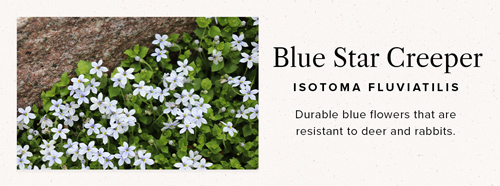
Blue Star Creeper (Isotoma fluviatilis)
| USDA Hardiness Zone: | 6-9 |
|---|---|
| Soil: | Moist but well-draining soil |
| Sun: | Partial shade to full sun |
| Blooms: | May to August |
Blue Star Creeper possesses several traits that make it great for ground cover. It grows between 3-6 inches and best of all it’s resistant to deer and rabbits. So if you live in a location where you have to worry about your vegetable garden getting eaten, you can surround strategic areas of your property with these blue flowers to help protect your veggies!
Hosta (Hosta sieboldiana)
| USDA Hardiness Zone: | 3-8 |
|---|---|
| Soil: | Damp, slightly acidic soil |
| Sun: | Prefers full shade but can survive with partial shade |
| Blooms: | May to July |
These white and purple blossoms provide an attractive option for areas where you don’t mind a little extra growth. Some varieties offer sweet scents so they make a great addition if you’re looking to create a floral aroma medley.
Bugleweed (Ajuga reptans)
| USDA Hardiness Zone: | 3-10 |
|---|---|
| Soil: | Dry soil |
| Sun: | Full sun or partial shade |
| Blooms: | Spring to early summer |
From the mint family, bugleweed blossoms with tiny bugle-shaped flowers in blue and white.
It’s famous (or infamous) as a ground cover because of its super fast-growing nature. Bugleweed can be an aggressive spreader so consider the location when you plant bugleweed as it can take over an area.
Canadian anemone (Anemone canadensis)
| USDA Hardiness Zone: | 3-8 |
|---|---|
| Soil: | Moist soil preferable |
| Sun: | Full sun or partial shade |
| Blooms: | Late spring to early summer |
Canadian anemone grows low and is a strong spreader. Foliage stays about a foot tall at most but its white flowers can reach up to 18 inches. It provides excellent erosion control and can work wonders in many different settings from deer-resistant plantings to cottage gardens to curbside and property borders. A cousin to Canadian anemone, round liverleaf (anemone americana) is another great ground cover.

Violet (Viola species)
| USDA Hardiness Zone: | 4-11 (Freckles), 6-11 (Horned) |
|---|---|
| Soil: | Average soil |
| Sun: | Full sun or partial shade |
| Blooms: | April to June |
Multiple varieties of violets work well as ground cover. Some of our favorites are “Freckles” (Viola sororia) and Horned Violet (Viola cornuta). Violet can create a pleasing woodland effect, and blossom with eye-catching purple and blue colors.
Yellow Alyssum (Aurinia saxatilis)
| USDA Hardiness Zone: | 3-7 |
|---|---|
| Soil: | Well-draining average or sandy soil |
| Sun: | Full sun |
| Blooms: | Spring |
As the name suggests, yellow alyssum blossoms with lovely yellow flowers. It is a strong grower, capable of reaching over a foot tall. After it blooms, prune it back to reduce legginess and possibly initiate a new round of blooms. Its heat and drought tolerant so makes a good planting for regions with hot summers.
Trailing Periwinkle (Vinca minor)
| USDA Hardiness Zone: | 4-8 |
|---|---|
| Soil: | Any soil from average to sandy to clay |
| Sun: | Partial sun or full shade |
| Blooms: | Early spring to summer |
Its blossoms arrive in shades of blue, lavender, purple, white during the summer. Trailing periwinkle thrives in shade but can grow so fast, it can be almost invasive. It stays low to the ground so if you need to fill a large space, it’s perfect.
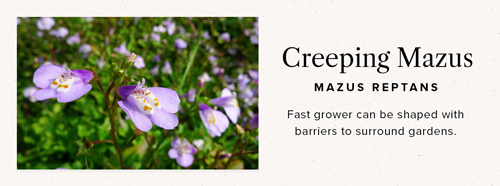
Creeping Mazus (Mazus reptans)
| USDA Hardiness Zone: | 5-8 |
|---|---|
| Soil: | Average well-draining soil |
| Sun: | Full sun and drought-tolerant |
| Blooms: | Mid-spring to early summer |
Creeping Mazus grows only 2 inches tall so it forms a dense carpet-like ground cover. IThis spreading quality makes it ideal for a ground cover. It does grow relatively quickly but not in a way to be considered potentially invasive. It looks great in and around rock gardens and other hardscapes. With barriers, it can easily be shaped into specific arrangements or patterns. Plant 20 inches spacing.
Dragon’s Blood Sedum (Sedum spurium)
| USDA Hardiness Zone: | 4-9 |
|---|---|
| Soil: | Loamy, sandy, and rocky soil |
| Sun: | Full sun and drought-tolerant |
| Blooms: | Early to late summer |
Dragon’s Blood Sedum gets its name from its deep red flowers. It grows horizontally along the ground so makes a great ground cover for a variety of locations. It looks great surrounding rock gardens fits nicely in areas that need drought-resistant plantings. Just remember it only blooms during the summer so take that into account when planting for color.
Lilyturf (lirope spicata)
| USDA Hardiness Zone: | 6-10 |
|---|---|
| Soil: | Rich, well-draining soil |
| Sun: | Full sun or partial shade |
| Blooms: | Late summer and early fall |
Can grow up to1-2 feet in height. Its blue, white, and purple blossoms look great when planted to encircle a garden or to secure a slope. Lilyturf is actually in the lily family but it can be planted as an ornamental grass. If its soil needs are met it can grow in a variety of conditions.
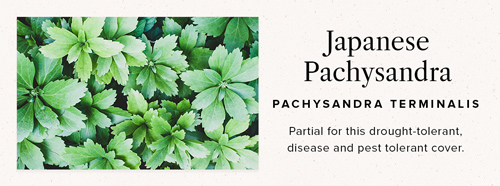
Japanese Pachysandra (Pachysandra terminalis)
| USDA Hardiness Zone: | 5-9 |
|---|---|
| Soil: | Rich, slightly acidic soil |
| Sun: | Partial or full shade |
| Blooms: | Spring |
Growing about 6 inches tall, Japanese Pachysandra grows fast and is drought tolerant (provided you protect it from the full sun). It works perfectly as a ground cover underneath trees where it superbly hides the roots. It’s also a great natural carpet for certain areas since it’s very durable and deer, insect, and disease resistant.
Sternkissen (Dianthus gratianopolitanus)
| USDA Hardiness Zone: | 3-9 |
|---|---|
| Soil: | Dry soil |
| Sun: | Full sun to partial shade |
| Blooms: | Spring and summer |
Growing only 2-4 inches with slow growth and drought-tolerant when established, Sternkissen will be perfect for many types of ground covers. It looks great for property borders, slopes, and curbsides as well as being suitable for rock gardens, alpine gardens, and fairy gardens. It emits a nice clove scent with pink and purple blossoms in star shapes. Just don’t prune in spring and fall, if it needs a haircut wait until late winter.
Brass buttons (Leptinella gruveri)
| USDA Hardiness Zone: | 7-9 |
|---|---|
| Soil: | Rich soil, acidic and loamy soil best suits it |
| Sun: | Full sun in cooler climates, partial shade in hotter climates |
| Blooms: | Late spring |
This adaptable ground cover doesn’t let weeds take root on your property. It grows low, forms a nice carpet, and works great for filling cracks and small areas. Its lush green color can fit into numerous aesthetics from Zen gardens to Mediterranean, rustic to tropical. You can use barriers to shape the area for brass buttons.
Wishbone Flower (Torenia fournieri)
| USDA Hardiness Zone: | 2-11 |
|---|---|
| Soil: | Moist but not soggy |
| Sun: | Full sun or partial shade |
| Blooms: | Mid-summer to mid-fall |
Also known as bluewing or clown flower, the blossoms have a resemblance to flowers in the same family like snapdragons and foxglove. Wishbone flower blooms all summer in shades of purple, pink, white, and yellow. It grows best with morning sun and afternoon shade but it can still survive on the shadiest parts of the property.Hummingbirds are attracted to its inch and a half blooms so if you’re planting a birds and bees-friendly garden, wishbone flower makes a great addition.
Lithodora (Lithodora diffusa)
| USDA Hardiness Zone: | 6-8 |
|---|---|
| Soil: | Well-draining soil, slightly acidic, not clay soil |
| Sun: | Partial shade |
| Blooms: | May through August |
With a preference for partial shade, lithodora can thrive in hot, dry regions with the right soil conditions. It blossoms in blue that makes an excellent cover to surround rock gardens or other outdoor hardscapes. It generally grows up to 12 inches. A hardy ground cover, it can also look fantastic when cascading down over walls or planters.
More Flowering Ground Covers
Do you have a specific trait you need for a ground cover? No problem.
The Fastest-Growing Ground Cover Plants?
- Phlox
- Thyme
- Golden Creeping Jenny
- Bugleweed
- Trailing Periwinkle
Best Low-Maintenance Ground Covers?
- Brass Buttons
- Woodruff
- Liverleaf
- Creeping juniper
- Ice Plant
Best Drought Tolerant Ground Covers
- Chinese lantern plant
- Alyssum
- Hens and Chicks
- Sternkissen
- Roman Chamomile
FAQ
What should I plant under a shade tree?
When deciding what to plant under a shade tree, the two things to consider are the sun requirements and if a ground cover can thrive growing over roots. A lot of woodland perennials and shrubs make good choices since they adapted to understory conditions. Some good choices are creeping juniper, snowdrops (galanthus), liriope/monkey grass, periwinkle, sweet woodruff, hydrangeas, hosta, pachysandra, and woodland anemones.
What should I plant on a steep slope?
For steep slopes, embankments, and hillsides, you want to select deep-rooted plants. Native plants tend to make the best choice since they will be low-maintenance and already adapted to the climate. Flowering shrubs are a good choice since their roots dig deep and help prevent erosion. Some good choices are creeping myrtle, weeping forsythia, creeping phlox, rock spray cotoneaster, and lamb’s ear. Shrub roses always make an attractive choice.
Do ground covers prevent weeds from growing?
Yes, some ground covers work outstanding at preventing weed growth. To prevent weeds, you want a resilient ground cover and can whose roots can choke out spaces for weeds. Dragon’s Blood Sedum is considered one of the best ground covers to prevent weeds. Some other good choices are varieties of thyme and lamb’s ear.





